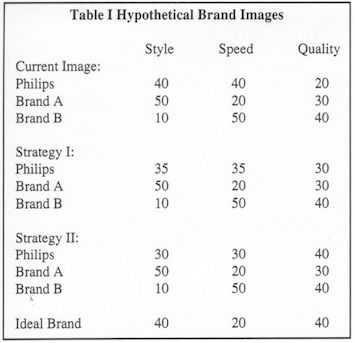Editor’s note: Betsy Goodnow is president of Market ACTION Research Software, Clarendon Hills, Illinois.
One peek into the future is worth more than a lifetime of hindsight, especially for corporations. Corporate executives need to predict the impact of various marketing strategies on their brand's competitive position. Scenario analysis of their brand's competitive position would help corporate executives evaluate alternative marketing strategies.
Many sophisticated consumer goods corporations now use correspondence analysis for competitive positioning because of its simplicity. In contrast to other types of perceptual mapping, correspondence analysis summarizes nominal data, rather than metric data. For example, respondents can simply check all images which apply to brands they know, instead of rating each brand on each image.
Correspondence analysis summarizes a crosstabulation of their aggregated responses by positioning brands and images on the perceptual map to best describe their relationships. A correspondence map describes the images of competitive brands by their proximity on the perceptual map. For example, if correspondence analysis positions the client's brand twice as close to a stylish image than a competitor and all other measures are equal, the client's brand is perceived as twice as stylish as the competitor.
Milton Peterson, director of marketing research of Philips Consumer Electronics, USA, uses correspondence analysis to evaluate alternative marketing plans. His approach to perceptual mapping shows executives at Philips Consumer Electronics how a change in a brand's image would effect its competitive position. This type of scenario analysis helps Philips select its marketing strategy and set its advertising objectives.
 |
The base-line measure would be the respondent's current perceptions of the images of competitive brands. The alternative scenarios are possible changes in the image of the Philips brand image as shown in Table I. For example, correspondence analysis can test how a 10 and 20 percent increase in its quality image would effect its competitive position and its relationship to the ideal brand. If the solution indicates that a 10 percent increase were sufficient to differentiate the Philip brand from competitors and to become the most ideal brand, the advertising objective could be a 10 percent, rather than a 20 percent, increase in the quality image of the Philips brand.
Correspondence analysis of the hypothetical scenarios in Table I shows that a 10 percent increase in the quality image of the Philips brand is not a sufficient to differentiate it from competitors and to become the most ideal brand. The correspondence map in Figure I reveals that in this scenario, Brand A would be most ideal since it is closest to the Ideal Brand. Furthermore, the Philips brand would have no distinct comparative advantage since it is located in the center of the map.
 |
In contrast, a 20 percent increase would achieve the marketing strategy. In this alternative scenario, the Philips brand is closest to the Ideal Brand and is distinguished from competitors by its quality image. Sensitivity analysis would determine exactly how much of an increase in the quality image of the Philips brand is required to achieve a satisfactory competitive position. For example, an 18 percent increase may be sufficient to achieve the marketing strategy while minimizing the advertising budget.
Additional factors could be considered in scenario analysis for competitive positioning. For example, superimposing the characteristics of the buyers would describe the target market of the Philips brand both before and after the change in its competitive positioning. This information would help Philips redirect its advertising message to its new target market. Furthermore, superimposing the features of the competitive brands on the solution would indicate which features are associated with a quality image. Then Philips would know how to improve the brand's quality and which features to emphasize in its advertising.
Scenario analysis of competitive positioning could be applied to any type of product, service, or idea. Although this approach requires a base-line study of the current positioning of competitive brands, no additional research costs are required to test out the effect of alternative advertising objectives on the brand's competitive position. However, another base-line study is required if the identity of competitors or salient images changes.
This approach allows corporate executives evaluate the impact of various advertising objectives on a brand's competitive positioning, to test out possible competitive reactions to changes in brand images, to scientifically set the advertising objective, and to logically justify an advertising budget. Thus, scenario analysis of competitive positioning lowers the risk of strategic decisions. According to Randy Emond, senior vice president for Market Planning of F.C.B/Leber Katz, "Correspondence analysis gives us a vision of the possibilities. It transforms numbers into a snapshot of the marketplace."
